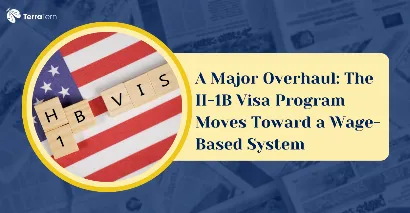Key Highlights
The U.S. immigration environment for skilled foreign workers is on the verge of intense change. The White House has taken the step of endorsing a proposed regulation that would radically change how H-1B visas are distributed and has been sending shockwaves through the technology sector as well as the global talent pool. The regulation, which is a measure to continue a Trump-era initiative, is intended to overtake the longstanding random lottery system and instead institute a system based on merit, which would focus on the level of wages earned by a worker. The ruling marks a second attempt to refocus H-1B visas on the most skilled and highest-paid workers and is in keeping with the spirit of Buy American, Hire American. Although the particular details have not yet been publicly released by U.S. Citizenship and Immigration Services (USCIS), the approval is a significant milestone in what may be the most significant H-1B reform in many years. The implications of this change are wide-ranging, and it is important to learn what the intentions behind it are, the history of such attempts, and how it can affect the employers and the foreign workers.
Also Read: US Visitor Visa B1/B2
The Shift from Lottery to Wages: A New Era for H-1B Selection
Almost every year of the last several decades, the H-1B visa program could be counted in the lottery of high stakes and uncertainty. Every year, around 85,000 visas (and a rather generous 20,000 visas granted to people with U.S. master's degrees), the USCIS would be subjected to hundreds of thousands of applications, which is often far more than the number of spaces offered. A computer-generated lottery was painfully impersonal and easy enough to select. Though fair on the face of it, this system has been overly criticised. What it did was induce a scenario where a junior developer with a low statistical probability of being chosen may have the potential of being chosen, and it would just be the same as high-salary senior software engineers in terms of chances. This has more often been interpreted to mean that the lottery system may have given rise to cases where some employers favoured low-wage foreign workers at the expense of their American counterparts. This is aimed to be solved with the new proposal that allows a merit-based, clear system of doing it.
Understanding the Current Lottery System and Its Criticisms
The existing random lottery system, such an easy way, generates a great deal of anxiety and uncertainty among the prospective employees and the companies. The mere size of applications ensures that there are tonnes of qualified candidates that are left out solely because of chance, and thus, companies are forced to miss out on the much-needed talent, and candidates must rethink their careers. It is a meritocracy that has turned into a gamble – the lottery. The same applicants have at times made companies, especially those in the tech industry, make repeated applications year on year, and this takes a lot of time and is an expensive procedure. The uncertainty has also made planning the workforce in the long run extremely hard. The major criticism, however, is that the lottery does not select on the grounds of skill, and critics of the lottery program say that this acts against the initial aim of getting in talent that is specialised and highly skilled but is not present in the U.S. labour market.
The Rationale Behind a Wage-Based System
The core principle of the new rule is straightforward: the higher the wage, the greater the priority. This tiered system is designed to favour employers who are willing to pay a premium for top-tier foreign talent. The rationale is that by prioritising applicants with higher wage offers, the system will naturally select for more experienced and specialised workers, while also ensuring that companies are not using the H-1B program to fill jobs at salaries below market rates. This approach is intended to protect American workers by reducing the incentive for companies to seek cheaper foreign labour and to ensure that the H-1B programme is used to complement, not displace, domestic talent. It is a fundamental shift from a system of chance to one based on economic value and skill, as determined by an applicant's salary.
Also Read: Intracompany Transfer Visa USA
A History of H-1B Reform Attempts: The Precedent for Change
The recent favourable report in the White House itself is not just a one-off occasion but can be viewed as a part of an extended framing of the new developments to regulate the H-1B relating to reforming the programme. The same rule was originally suggested by the Trump administration within the context of the overall policy of the Trump administration, which was suggested as Buy American, Hire American. That was the plan to have a tier system so that H-1B visas are given according to four wage levels, the highest-wage jobs being prioritised first, as recommended by the Department of Homeland Security (DHS) in 2021. This attempt was challenged and faced much opposition by a wide range of stakeholders, which included the tech companies and the immigration advocates, including an immediate legal challenge.
The "Buy American, Hire American" Policy's Legacy
Immediately after the Biden administration assumed the executive seat, it promptly withdrew the proposed DHS rule on the basis that it may end up decreasing the number of qualified foreign workers and stifling American competitiveness. The ruling government then chose to consider the H-1B programme subject to a broader prism. This new approval, however, is a strategic shift and a turn back to the initial concept of that earlier proposal. This implies that even after the above withdrawal, the premise of a wage-oriented system is still potent among some quarters of the government. The motivation behind this renewed push may be tempered by an attempt to tighten the integrity of the H-1B programme and quell the long-suspected claims that the programme has been abused by allowing companies to use it to staff Wal-Mart shelves rather than higher-level occupations. This new suggestion could be said to be the legacy of the values of the Buy American, Hire American policy, as the ideas have continued to influence the immigration discourses.
Potential Impacts and Stakeholder Perspectives
There can be a paradigm shift among different stakeholders due to the possibility of implementing this new rule. In the case of large technological corporations that depended on the continuous growth of foreign talent, the shift will probably result in a modification of recruitment. They might have to change the salaries offered to make sure that their candidates stand a chance to receive the few visas available. The rule was also seen to be beneficial to smaller, highly specialised companies, which could pay the highest wages for niche skills but have in the past suffered at the whims of the lottery system. It is a mixed bag to foreign workers. There was a greater likelihood of getting a visa, especially for those highly skilled and experienced professionals whose salary offers were very high. The postgraduates or fresh graduates looking into entry-level jobs would probably be at a disadvantage, though, based on the fact that they will be fighting with both a larger pool of applicants on the same visas and the offerings of higher rates.
Also Read: How Many Types of Visa in USA? New Full Expert Guide
A New Landscape for Tech and Talent
The technology industry that depends greatly on H-1B visas to cover a broad spectrum of professionals will have to adjust. That would direct towards a more serious approach to looking into internal stateside talent or even spreading to other nations. This reform may also be used to encourage firms to reinvest in more training and upskill their native workforce. The H-1B programme, which used to be one of the key tools for attracting a wide range of foreign talent to the United States, can be transformed into a more discriminating tool for attracting just the most senior and highly paid professionals. Such would shake the talent pipeline of most companies and might as well be perceived as a form of securing elite talent or a form of restriction that inhibits innovation and expansion.
Conclusion
While the White House's approval of a wage-based H-1B visa system marks a significant step, the implementation journey is far from over. The proposal's public release and subsequent comment period will be critical in shaping the final rule, and it could face legal challenges, just as previous attempts have. This shift from a lottery to a merit-based system, prioritising higher-paid workers, will undoubtedly reshape the U.S. talent landscape. For both American employers and international professionals, staying informed about the ongoing developments and preparing for a potentially more competitive and selective H-1B program is now more important than ever. The future of skilled immigration to the U.S. hangs in the balance.
To stay updated about the latest immigration news, contact TerraTern right away!








